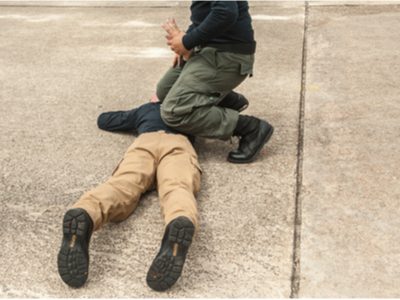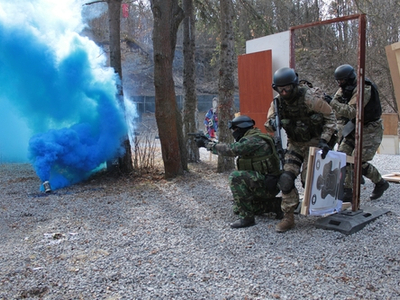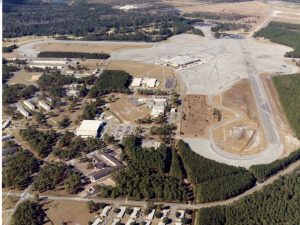Top Police Academies in the US
Just as lawyers go to law school and soldiers complete basic training, aspiring police officers must pass through a specialized training program and proving ground of their own: police academy. A good police academy will challenge your limits both physically and mentally, but the experience is a transformational rite of passage for every cop in America—and what you learn there could save your life, or someone else’s, one day.

Why Become a Police Officer?
Every single shift you work as a police officer is an opportunity to directly and positively impact the quality of life in your own community. Whether you are patrolling a dangerous part of town, responding to a call about domestic abuse, or writing up the details of an accident, you are making a difference in your community and helping to keep it safe.
The citizens you serve will entrust you with incredible power, but with that power comes responsibility. You’ll be expected to live by an oath to protect and serve, even at the cost of your own life.
Police work is not for everyone, but if you can handle the stress and the scrutiny, the danger and the demands, the career of a police officer is more than just a job—it’s a proud calling and a lifestyle. Learn more about what it’s like to work as a police officer.
Finding a Top Police Academy
To find a top police academy, you need to think about your career goals. Is your primary goal to work in the trenches as a police officer? Are you interested in working for federal law enforcement? Or do you want to rise in the ranks to a supervisory position or a specialty position such as police detective?
For all of these goals, you will attend a police academy—but you might take different pathways. You can:
- Attend a local police academy that is specifically geared to police training
- Attend a federal police academy to train for federal law enforcement positions
- Attend a community college or university to combine police academy training with getting a certificate or degree in law enforcement or criminal justice
Local Police Academy
In most states, you’ll have plenty of police academies to choose from. Although proximity may be a factor, there are other things to consider.
Former Madison, Wisconsin Police Chief David Couper recommends choosing an academy that meets the following criteria:
- The academy should be a modern, 21st-century police training academy with an intellectual atmosphere that’s more like a university than a trade school.
- It should not be patterned after military boot camps—any “stressing” of students should be specifically job-related.
- The program should be value-based and mission-oriented with a strong focus on our Bill of Rights and the workings of a free and democratic society.
- It must include a year or more of field training with a seasoned Field Training Officer (FTO).
- It should focus on increasing the maturity and emotional intelligence (EQ) of its students.
- The program should celebrate diversity and foster honest and open discussions about race and policing and the trust gap in our nation between police and citizens of color.
In addition to these guidelines, to find a top school talk to graduates of the academy you are looking into, as well as teachers and other staff. Go look at the facility and, if possible, view some of the training sessions. And make sure the academy is approved by your state.
David Couper, former police chief in Madison, Wisconsin, is a proponent of the idea that police should be partners in not just protecting society but improving it. His blog, Improving Police, discusses the many issues that face law enforcement today and is a forum for possible solutions.
Federal Police Academy
To train for federal law enforcement agencies, you will most likely attend the Federal Law Enforcement Training Centers (FLETC). FLETC is an interagency training academy for 91 United States government law enforcement agencies, including the Department of Homeland Security, United States Secret Service, and Federal Bureau of Alcohol, Tobacco, Firearms, and Explosives.
The FLETC facility, which is based in Glynco, Georgia, is massive—it’s actually considered a town and has its own zip code! Trainees usually live on site in dormitories. Training facilities include 18 firearms ranges, an explosives range, driver training ranges, and a 34-building “neighborhood” practice exercise area.
Community College or University
Aspiring officers can find programs in police science, law enforcement, or criminal justice that combine police training with academic courses.
Note that more and more police departments are requiring candidates to have at least several years of college. In addition, the possibility for higher pay and advancement opportunities lead many students to earn a degree.
In order to find a top college or university for police training, look for the following:
- What is the program’s job placement rate?
- Does the program provide practical experience that involves “shadowing” local police officers?
- Does the school offer non-training courses that you are interested in?
- Is the program state-approved?
- Does the school offer tuition assistance?
If cost is an issue, check out our Criminal Justice Trailblazer Scholarship, which offers a $1,000 award for criminal justice students. Also refer to our scholarship guide for criminal justice degrees.
What Is Police Academy Training Like?
Academy training is designed to prepare America’s police officers for the rigors of one of the world’s most stressful, high-stakes, and intense occupations. Law enforcement was always difficult and dangerous work, but social media and smartphones put today’s officers under a level of intense and often unforgiving public scrutiny that previous generations never experienced.

To prepare you for the crucible ahead, police academy training is designed to be physically and psychologically taxing—but there’s also a great deal of academic learning. You’ll receive practical and classroom instruction on state and federal laws, criminal investigation procedures, and departmental policies and protocols. Your education should promote a thoughtful and serious examination of the balance between enforcing the law and preserving the rights and freedoms of the people you encounter every day.

You’ll also become intimately familiar with the tools and tactics of the trade. That means mastering firearms and other weapons, tactical driving, hand-to-hand combat, and learning how to take people into custody and transfer them to jails. The physical nature of the work demands that police officers stay in shape. Police academies train and test for physical fitness, strength, and endurance, although specific regimens and requirements vary by state and department. For example, Birmingham, Alabama, requires that you can:
- Scale a 6-foot fence
- Crawl through a 2-by-2 window opening
- Push a car 15 feet
- Drag a 165-pound dummy 5 yards
- Walk 5 yards on a balance beam
- Run a mile and a half within 15 minutes and 28 seconds
Top States for Police Officers
There are a number of factors that might make a state a good place to work as a police officer. You might consider salary to be at the top of the list. Job growth is another factor you should consider. And for some of you, the prevalence of violent crime might be a major issue.
Take a look at the statistics for each of these factors. Focus on the ones that matter to you to decide which states might be the best places for you to work.
Note: All of the following data comes from the Bureau of Labor Statistics (BLS) unless otherwise specified.
Salary
The average annual salary for police officers is higher than that of all combined occupations in nearly every state. Some states, however, offer especially lucrative salaries. These are the top five states with the highest mean wage.
| State | Mean Annual Salary |
| California | $104,010 |
| Washington | $92,250 |
| New Jersey | $90,520 |
| Hawaii | $89,640 |
| Alaska | $85,710 |
If you’re a resident of the Golden State, you’re in luck. Every one of America’s 10 highest-paying cities for police officers are in California.
| Metropolitan Area | Annual Mean Wage |
| San Jose-Sunnyvale-Santa Clara, CA | $129,710 |
| San Francisco-Oakland-Hayward, CA | $119,460 |
| Vallejo-Fairfield, CA | $117,150 |
| Napa Santa Rosa, CA | $109,730 |
| Santa Maria-Santa Barbara, CA | $108,410 |
| Redding, CA | $107,650 |
| Santa Cruz-Watsonville, CA | $105,330 |
| Oxnard-Thousand Oaks-Ventura, CA | $105,010 |
| Los Angeles-Long Beach-Anaheim, CA | $104,270 |
| Salinas, CA | $103,770 |
It’s also important to consider how police salaries stack up against other occupations across your state. As mentioned, police officers earn more than the average worker in most of the country. The gap between is biggest in the following states:
| State | Percentage Above Average |
| California | 70% |
| Alaska | 50% |
| Nevada | 50% |
| Hawaii | 40% |
| Illinois | 40% |
Career Outlook
Another key metric is projected job growth, which for police officers is 2% to 4% in the nation as a whole. O*Net reports these states to have projected growth for police officers of 11% or higher through 2032.
| State | Predicted Job Growth |
| Utah | 20% |
| Maryland | 15% |
| Nevada | 15% |
| New York | 14% |
| South Carolina | 14% |
| Texas | 13% |
| Montana | 13% |
| Oregon | 13% |
| Colorado | 16% |
| Iowa | 12% |
| Delaware | 11% |
| North Dakota | 11% |
| Arkansas | 11% |
| Washington | 11% |
Crime Rate
Danger is inherent to police work no matter where you live, but some states and cities are more dangerous than others. Maine has the lowest violent crime rate in America. On the other end of the spectrum is Washington D.C., whose residents experience more violent crime than any of the 50 states.
If the prevalence of violent crime is a concern for you, check out these tables to help you decide where you might want to work.
According to the FBI report Crime in the United States, 2018, the following 10 states had the lowest violent crime rates in 2018 (crime rates are measured as number of incidents per 100,000 inhabitants):
| State | Violent Crime Rate |
| Maine | 112.1 |
| Vermont | 172.0 |
| New Hampshire | 173.2 |
| Virginia | 200.0 |
| Connecticut | 207.4 |
| New Jersey | 208.1 |
| Kentucky | 211.9 |
| Wyoming | 212.2 |
| Rhode Island | 219.1 |
| Minnesota | 220.4 |
These rates are all well below the national average of 380.6.
The top 10 states with the highest violent crime rates in 2018 were:
| State | Violent Crime Rate |
| District of Columbia (D.C.) | 995.9 |
| Alaska | 885.0 |
| New Mexico | 856.6 |
| Tennessee | 623.7 |
| Arkansas | 543.6 |
| Nevada | 541.1 |
| Louisiana | 537.5 |
| Alabama | 519.6 |
| Missouri | 502.1 |
| South Carolina | 488.3 |
The top 20 metropolitan areas with the lowest violent crime rates in 2018 were:
| City | Violent Crime Rate |
| Bangor, ME | 73.8 |
| Provo-Orem, UT | 87.8 |
| Logan, UT-ID | 89.8 |
| State College, PA | 98.3 |
| Elizabethtown-Fort Knox, KY | 113.7 |
| Portland-South Portland, ME | 114.5 |
| Montgomery County-Bucks County-Chester County, PA | 120.0 |
| Gettysburg, PA | 129.9 |
| Winchester, VA-WV | 135.3 |
| Rockingham County-Strafford County, NH | 132.6 |
| Glens Falls, NY | 136.1 |
| Harrisonburg, VA | 136.6 |
| La Crosse-Onalaska, WI-MN | 137.5 |
| Lewiston, ID-WA | 138.3 |
| Wausau-Weston, WI | 139.8 |
| Fond du Lac, WI | 141.1 |
| Rochester, MN | 142.0 |
| Ithaca, NY | 142.3 |
| Midland, MI | 142.4 |
| Appleton, WI | 143.4 |
The top 20 metropolitan areas with the highest violent crime rates in 2018 were:
| City | Violent Crime Rate |
| Anchorage, AK | 1,263.6 |
| Farmington, NM | 1,199.8 |
| Memphis, TN | 1,142.5 |
| Albuquerque, NM | 1,084.7 |
| Detroit-Dearborn-Livonia, MI | 1,001.8 |
| Danville, IL | 931.9 |
| Pine Bluff, AR | 880.4 |
| Hammond, LA | 849.1 |
| Lubbock, TX | 829.3 |
| Wichita, KS | 826.0 |
| Stockton, CA | 795.1 |
| Alexandria, LA | 775.3 |
| Philadelphia, PA | 763.7 |
| Odessa, TX | 760.6 |
| Florence, SC | 748.2 |
| Rockford, IL | 742.6 |
| Little Rock-North Little Rock-Conway, AR | 738.1 |
| Albany, GA | 728.5 |
| Anniston-Oxford, AL | 726.0 |
| Monroe, LA | 724.6 |
| Baltimore-Columbia-Towson, MD | 720.8 |
Interested in learning more? Check out how to become a K9 officer.






